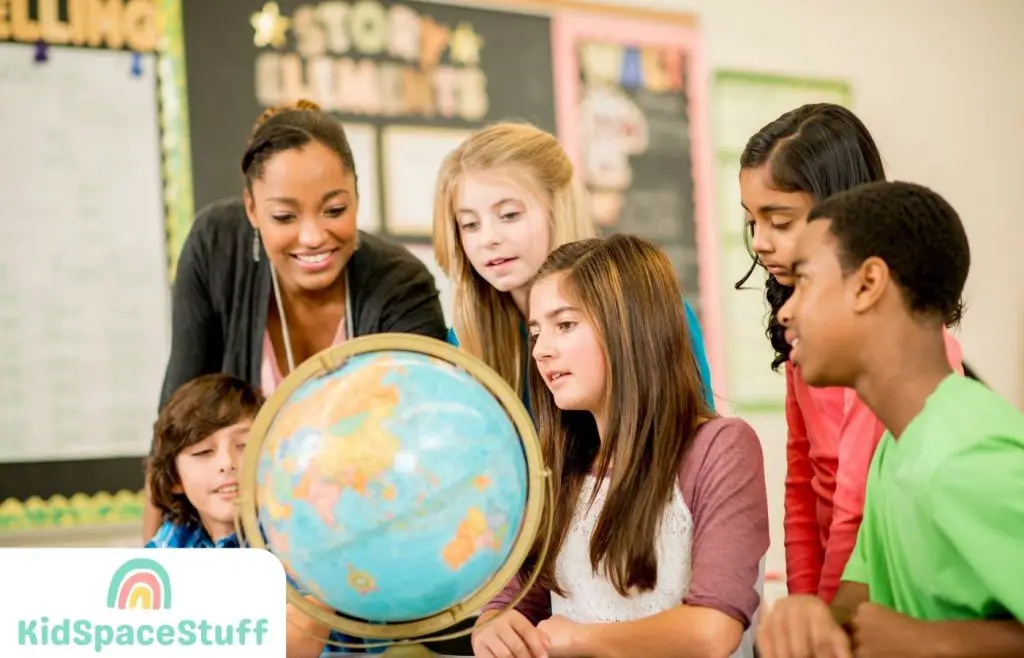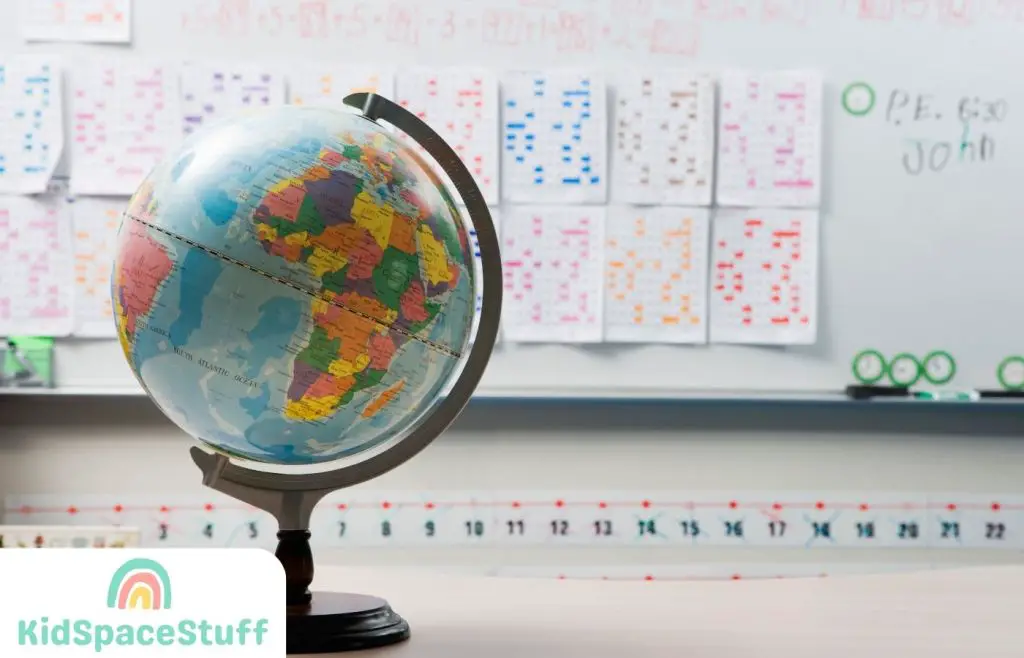Are you wondering what grade your kids learn geography?
Geography is a subject that broadens our horizons, allowing us to travel the world from the confines of a classroom and teaching us about the intricate links between people and their environment.
In this article, I’ll guide you through the progressive stages of geography education, highlighting when students typically encounter this fascinating subject, the areas of focus at each educational level, and the invaluable skills that geography instills.
From elementary to high school, we’ll delve into the enriching journey of geography education that aids students in appreciating and understanding our diverse world. Let’s dig in!
What Grade Do You Learn Geography?

Geography education often begins in elementary school, typically around 1st or 2nd grade, where students are introduced to basic concepts such as recognizing shapes and symbols, reading maps, and learning about their local environment.
Elementary School Geography
In this stage, you usually start by learning about our local environment, such as our town or city, and gradually expand our understanding to cover our country.
Elementary school tends to focus on the basics: understanding what maps are, recognizing different landforms, and learning about basic human and physical geography concepts. At this level, teaching geography is more focused on helping us develop spatial awareness and curiosity about the world.
Looking to help your kids learn geography? Check out these amazing globes for kids!
Middle School Geography
As you move into middle school, the geography curriculum started to get more complex, introducing topics like regional and world geography.
In these grades, you’ll explore the relationships between people, places, and environments. This is when you take a closer look at the physical and political maps of the world and begin to learn about the different countries and cultures.
Your education starts to venture into topics such as climate, resources, and population. You may even take part in geography-related projects and examine the different factors that affect our world.
High School Geography
In your high school years, you’ll delve deeper into the subject.
Here, geography education covers a wide range of topics such as human geography, environmental geography, and even geospatial technology.
You’ll tackle complex questions about global issues, such as migration, urbanization, and climate change. High school geography also involves more analysis and interpretation of data, which can be presented through maps, graphs, and other visual representations. At this point, your understanding of geography as a whole becomes more sophisticated, as you grasp the interconnections in our world and the implications of our actions on a global scale.
The Importance of Geography

Exploring the Earth
As a geography enthusiast, I find that the study of geography allows me to better understand the Earth and its diverse landscapes.
By discovering how places are formed and how they change over time, you can appreciate the beauty and complexity of our planet.
Geography also helps you learn about maps, which are essential tools for navigating our world and getting a sense of where everything is located. Through geography, you’ll gain valuable skills that enable you to analyze spatial data and make informed decisions about your surroundings.
Why Study Geography
There are numerous reasons why we should study geography.
Personally, studying geography has deepened my understanding of the connection between people and their environments. I have learned how human actions can shape the land and how, in turn, the natural environment influences cultures and societies.
Leaning geography also teaches students crucial skills such as problem-solving, critical thinking, and spatial awareness. These skills are not only useful in studying geography but are also transferable to various aspects of life, including history, science, and even math.
In short, geography plays a critical role in providing a well-rounded education and enriching our understanding of the world around us.
Types of Geography
Geography enthusiasts appreciate the vast and diverse field it represents. It’s generally understood that geography can be divided mainly into two sub-fields: Physical Geography and Human Geography. Here is a brief overview of these two captivating areas.
Physical Geography
Physical geography centers around understanding Earth’s natural phenomena. It delves into the physical properties of the Earth’s surface, like oceans, landforms, and natural resources. Physical geography allows the exploration of various aspects like climate, weather, and vegetation, giving a broader understanding of the world.
For example, when one learns about the oceans, it’s discovered that they cover about 70% of the Earth’s surface and play a significant role in regulating the climate. The study of natural resources like forests, water, and minerals heightens their appreciation for their importance in sustaining life on Earth and the need for their responsible management.
Looking to learn geography? Check out the video below!
Human Geography
Human geography provides a study of the connection between people and their environments. This field revolves around understanding how human societies adapt to and transform the spaces they occupy over time.
As the world of human geography is explored, cities and their development become a fascinating topic. It’s intriguing to observe how populations grow, interact, and shape the landscapes around them. The study of human geography also introduces the concept of spatial association, aiding in the analysis of how different places and phenomena are related.
In conclusion, learning about geography provides a fascinating journey across the Earth, its oceans, and the diverse societies that inhabit it. Studying geography fosters a much deeper appreciation and understanding of the world, both natural and human-made.
Geography Skills and Tools
Cartography
For those who love geography, the art and science of cartography is fascinating. This includes creating and interpreting maps, essential tools in understanding the world. Maps help visualize geographic information, such as the location and distribution of physical and cultural features. Basic principles of cartography are critical, including understanding the difference between a map’s scale, legend, and the various types of projections. Utilizing color and symbols to emphasize important aspects of a map makes it easier to grasp complex information quickly and efficiently.
GIS
Geographic Information Systems (GIS) is another essential area. GIS is a powerful digital tool that allows for storing, analyzing, and visualizing spatial data. It integrates various data layers to create a comprehensive picture of the world. Using GIS, spatial relationships can be analyzed, patterns identified, and informed decisions made.
GIS has numerous applications, ranging from disaster management to urban planning. This technology has transformed the way geographic information is perceived and analyzed.
GPS
Understanding the Global Positioning System (GPS) is a crucial part of learning geography. The fact that satellites orbit the Earth providing real-time location data is astounding! GPS technology allows for the pinpointing of exact locations, finding directions, and even tracking the movement of objects.
GPS has revolutionized navigation, with countless applications in daily lives. From ride-sharing apps to geocaching adventures, it’s hard to imagine a world without GPS.
Final Thoughts
So, when do kids learn geography?
Geography is typically taught to students starting in the first or second grade. It begins with basic concepts like understanding maps and learning about the local environment. As students progress through their school years, the subject matter becomes more complex, expanding to include regional, national, and eventually global geography.
Have other questions about your child’s education? Check out these posts!
- What Grade Do Kids Learn Multiplication?
- When Do Kids Learn Division?
- When Do Children Learn Colors?
KidSpaceStuff is a site dedicated to helping parents find the best interior design, activities, and inspiration for their kids.